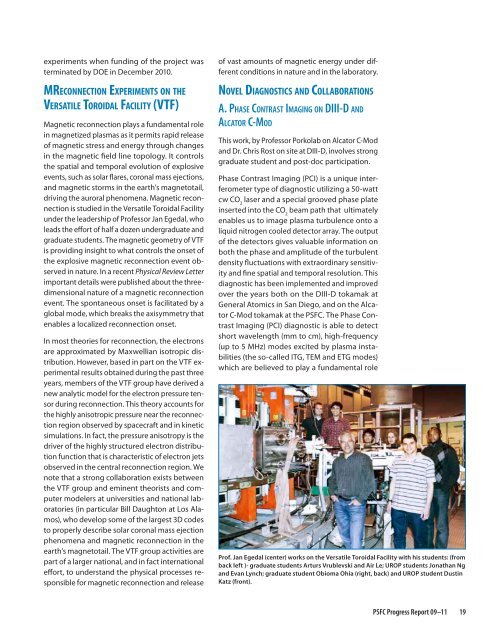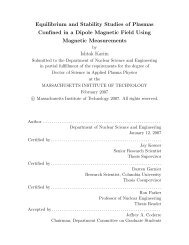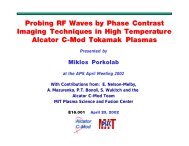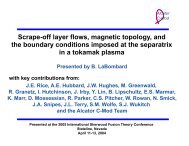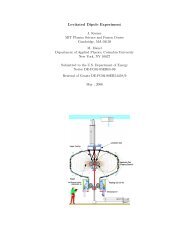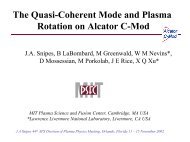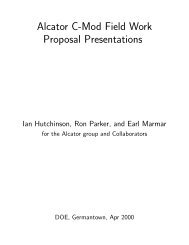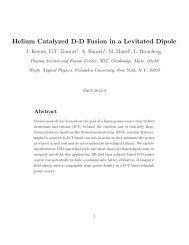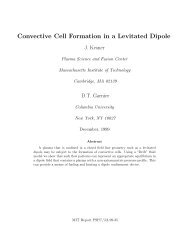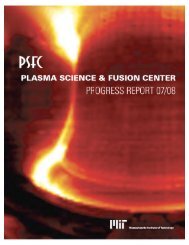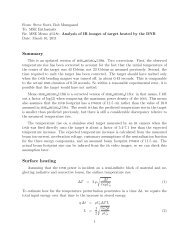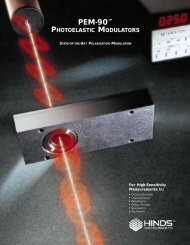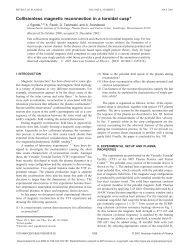Download a copy of the latest PSFC Progress Report - Plasma ...
Download a copy of the latest PSFC Progress Report - Plasma ...
Download a copy of the latest PSFC Progress Report - Plasma ...
Create successful ePaper yourself
Turn your PDF publications into a flip-book with our unique Google optimized e-Paper software.
experiments when funding <strong>of</strong> <strong>the</strong> project was<br />
terminated by DOE in December 2010.<br />
MReconnection Experiments on <strong>the</strong><br />
Versatile Toroidal Facility (VTF)<br />
Magnetic reconnection plays a fundamental role<br />
in magnetized plasmas as it permits rapid release<br />
<strong>of</strong> magnetic stress and energy through changes<br />
in <strong>the</strong> magnetic field line topology. It controls<br />
<strong>the</strong> spatial and temporal evolution <strong>of</strong> explosive<br />
events, such as solar flares, coronal mass ejections,<br />
and magnetic storms in <strong>the</strong> earth’s magnetotail,<br />
driving <strong>the</strong> auroral phenomena. Magnetic reconnection<br />
is studied in <strong>the</strong> Versatile Toroidal Facility<br />
under <strong>the</strong> leadership <strong>of</strong> Pr<strong>of</strong>essor Jan Egedal, who<br />
leads <strong>the</strong> effort <strong>of</strong> half a dozen undergraduate and<br />
graduate students. The magnetic geometry <strong>of</strong> VTF<br />
is providing insight to what controls <strong>the</strong> onset <strong>of</strong><br />
<strong>the</strong> explosive magnetic reconnection event observed<br />
in nature. In a recent Physical Review Letter<br />
important details were published about <strong>the</strong> threedimensional<br />
nature <strong>of</strong> a magnetic reconnection<br />
event. The spontaneous onset is facilitated by a<br />
global mode, which breaks <strong>the</strong> axisymmetry that<br />
enables a localized reconnection onset.<br />
In most <strong>the</strong>ories for reconnection, <strong>the</strong> electrons<br />
are approximated by Maxwellian isotropic distribution.<br />
However, based in part on <strong>the</strong> VTF experimental<br />
results obtained during <strong>the</strong> past three<br />
years, members <strong>of</strong> <strong>the</strong> VTF group have derived a<br />
new analytic model for <strong>the</strong> electron pressure tensor<br />
during reconnection. This <strong>the</strong>ory accounts for<br />
<strong>the</strong> highly anisotropic pressure near <strong>the</strong> reconnection<br />
region observed by spacecraft and in kinetic<br />
simulations. In fact, <strong>the</strong> pressure anisotropy is <strong>the</strong><br />
driver <strong>of</strong> <strong>the</strong> highly structured electron distribution<br />
function that is characteristic <strong>of</strong> electron jets<br />
observed in <strong>the</strong> central reconnection region. We<br />
note that a strong collaboration exists between<br />
<strong>the</strong> VTF group and eminent <strong>the</strong>orists and computer<br />
modelers at universities and national laboratories<br />
(in particular Bill Daughton at Los Alamos),<br />
who develop some <strong>of</strong> <strong>the</strong> largest 3D codes<br />
to properly describe solar coronal mass ejection<br />
phenomena and magnetic reconnection in <strong>the</strong><br />
earth’s magnetotail. The VTF group activities are<br />
part <strong>of</strong> a larger national, and in fact international<br />
effort, to understand <strong>the</strong> physical processes responsible<br />
for magnetic reconnection and release<br />
<strong>of</strong> vast amounts <strong>of</strong> magnetic energy under different<br />
conditions in nature and in <strong>the</strong> laboratory.<br />
Novel Diagnostics and Collaborations<br />
A. Phase Contrast Imaging on DIII-D and<br />
Alcator C-Mod<br />
This work, by Pr<strong>of</strong>essor Porkolab on Alcator C-Mod<br />
and Dr. Chris Rost on site at DIII-D, involves strong<br />
graduate student and post-doc participation.<br />
Phase Contrast Imaging (PCI) is a unique interferometer<br />
type <strong>of</strong> diagnostic utilizing a 50-watt<br />
cw CO 2<br />
laser and a special grooved phase plate<br />
inserted into <strong>the</strong> CO 2<br />
beam path that ultimately<br />
enables us to image plasma turbulence onto a<br />
liquid nitrogen cooled detector array. The output<br />
<strong>of</strong> <strong>the</strong> detectors gives valuable information on<br />
both <strong>the</strong> phase and amplitude <strong>of</strong> <strong>the</strong> turbulent<br />
density fluctuations with extraordinary sensitivity<br />
and fine spatial and temporal resolution. This<br />
diagnostic has been implemented and improved<br />
over <strong>the</strong> years both on <strong>the</strong> DIII-D tokamak at<br />
General Atomics in San Diego, and on <strong>the</strong> Alcator<br />
C-Mod tokamak at <strong>the</strong> <strong>PSFC</strong>. The Phase Contrast<br />
Imaging (PCI) diagnostic is able to detect<br />
short wavelength (mm to cm), high-frequency<br />
(up to 5 MHz) modes excited by plasma instabilities<br />
(<strong>the</strong> so-called ITG, TEM and ETG modes)<br />
which are believed to play a fundamental role<br />
Pr<strong>of</strong>. Jan Egedal (center) works on <strong>the</strong> Versatile Toroidal Facility with his students: (from<br />
back left )- graduate students Arturs Vrublevski and Air Le; UROP students Jonathan Ng<br />
and Evan Lynch; graduate student Obioma Ohia (right, back) and UROP student Dustin<br />
Katz (front).<br />
<strong>PSFC</strong> <strong>Progress</strong> <strong>Report</strong> 09–11 19


